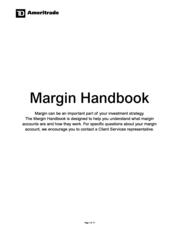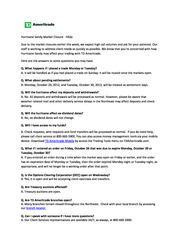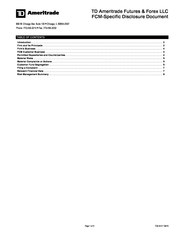Description
Regulation T Call—a federal margin call for the deposit of the initial
equity required under Regulation T promulgated by the Federal
Reserve Board.
Regulation T Excess—in a margin account, the amount by which
the equity exceeds the current initial margin requirements of the
positions held.
Regulation T (Reg T)—a Federal Reserve Board regulation that
governs the lending of money by brokerage firms to clients.
Restricted Account—as defined by Regulation T, a margin account
in which the debit balance exceeds the loan value. TD Ameritrade,
Inc. may restrict an account for 90 days when a Regulation T call
has not been satisfied by the due date.
Risk Array—a set of stress testing price points for an underlying
security that is used to determine the theoretical max loss which will
be used as the maintenance requirement for that position. Typically
the stressed price points are equidistant.
Securities—a general term used to describe any kind of investment
product, though it can also refer specifically to stocks and bonds.
Securities and Exchange Commission (SEC)—the federal
agency responsible for the enforcement of laws governing the
securities industry.
Sell/Write—an advanced options order that combines the short
selling of an equity and the selling of a put option on the same
underlying stock.
Series—all options contracts of the same class that also have the
same unit of trade, expiration date, and exercise price.
Short Account—account in which the client has short sold securities.
Before a client may sell short, a margin account must be opened.
Short Position—a position in a client’s account in which the client
either owes securities to the firm or has some other obligation to meet.
Short Sale—the sale of securities that are not owned or that are not
intended for delivery.
The short seller “borrows” the stock to make delivery, with the intent to buy it back at a later date at a lower price. Straddle—simultaneous long or short positions of puts and calls having the same underlying security and same strike price. Strangle—an options strategy that refers to writing a call and a put, with different strike prices, on the same underlying security. Strike (Exercise) Price—the stated price per share for which the underlying asset may be purchased (in the case of a call) or sold (in the case of a put) upon exercise of an options contract. Trade Date—the day a trade occurs. Trades generally settle (are paid for) one to five business days after the trade date. Treasury Bills—obligations issued by the Department of the Treasury maturing in 13, 26, or 52 weeks. Treasury Bond—long-term (10 to 30 years), fixed-interest government debt security. Treasury Note—medium-term (one to 10 years), fixed-interest government debt security. Uncovered Call—a short call-options position in which the writer does not own shares of the underlying stock represented by his options contracts. Also called a “naked” call, it is much riskier for the writer than a covered call, where the writer owns the underlying stock.
If the holder of this call option exercises the option to call, the writer would be forced to buy the stock at market price. The nature of uncovered call options means that the writer’s risk is unlimited. Uncovered Put—a short put-options position in which the writer either does not have a corresponding short stock position or has not deposited cash or cash equivalents equal to the exercise value of the put. Also called “naked” puts, the writer has pledged to buy the stock at a certain price if the holder of the option chooses to exercise it.
The risk of writing uncovered put options is substantial. Volatility—relative measure of a security’s price movement during a specific time. It is measured mathematically by the annual standard deviation of daily stock-price changes. Writer—the seller of an options contract when opening a new options position. SMA (Special Memorandum Account)—SMA is a separate margin account maintained by the brokerage firm. The SMA is the most misunderstood account in the brokerage industry.
The main purpose of the SMA is to preserve the client’s buying power. When the equity in an account exceeds the required 50% (for Regulation T), excess equity is created. This excess equity is known as SMA.
When excess equity exists in a margin account, an entry is made to SMA. Once this entry is credited to the SMA, it remains there until used. It does not disappear even if the account loses the excess equity that created the SMA in the first place. Stocks held in a margin account that go up in price create SMA, but a later decrease in the price of the same stocks doesn’t decrease the SMA. Spread—the difference between the bid and offer sides of a quote. Spread Order—an advanced options order that combines the purchase and sale of either puts or calls on the same underlying security. Stock—(1) a share in the ownership of a company; (2) an investment product that represents part ownership in a corporation. Investment Products: Not FDIC Insured * No Bank Guarantee * May Lose Value TD Ameritrade Inc.
and TD Ameritrade Clearing, Inc., members FINRA/SIPC. TD Ameritrade is a trademark jointly owned by TD Ameritrade IP Company, Inc. and The Toronto-Dominion Bank.
© 2016 TD Ameritrade IP Company, Inc. All rights reserved. Used with permission. Page 17 of 17 AMTD 086 F 02/16 .
The short seller “borrows” the stock to make delivery, with the intent to buy it back at a later date at a lower price. Straddle—simultaneous long or short positions of puts and calls having the same underlying security and same strike price. Strangle—an options strategy that refers to writing a call and a put, with different strike prices, on the same underlying security. Strike (Exercise) Price—the stated price per share for which the underlying asset may be purchased (in the case of a call) or sold (in the case of a put) upon exercise of an options contract. Trade Date—the day a trade occurs. Trades generally settle (are paid for) one to five business days after the trade date. Treasury Bills—obligations issued by the Department of the Treasury maturing in 13, 26, or 52 weeks. Treasury Bond—long-term (10 to 30 years), fixed-interest government debt security. Treasury Note—medium-term (one to 10 years), fixed-interest government debt security. Uncovered Call—a short call-options position in which the writer does not own shares of the underlying stock represented by his options contracts. Also called a “naked” call, it is much riskier for the writer than a covered call, where the writer owns the underlying stock.
If the holder of this call option exercises the option to call, the writer would be forced to buy the stock at market price. The nature of uncovered call options means that the writer’s risk is unlimited. Uncovered Put—a short put-options position in which the writer either does not have a corresponding short stock position or has not deposited cash or cash equivalents equal to the exercise value of the put. Also called “naked” puts, the writer has pledged to buy the stock at a certain price if the holder of the option chooses to exercise it.
The risk of writing uncovered put options is substantial. Volatility—relative measure of a security’s price movement during a specific time. It is measured mathematically by the annual standard deviation of daily stock-price changes. Writer—the seller of an options contract when opening a new options position. SMA (Special Memorandum Account)—SMA is a separate margin account maintained by the brokerage firm. The SMA is the most misunderstood account in the brokerage industry.
The main purpose of the SMA is to preserve the client’s buying power. When the equity in an account exceeds the required 50% (for Regulation T), excess equity is created. This excess equity is known as SMA.
When excess equity exists in a margin account, an entry is made to SMA. Once this entry is credited to the SMA, it remains there until used. It does not disappear even if the account loses the excess equity that created the SMA in the first place. Stocks held in a margin account that go up in price create SMA, but a later decrease in the price of the same stocks doesn’t decrease the SMA. Spread—the difference between the bid and offer sides of a quote. Spread Order—an advanced options order that combines the purchase and sale of either puts or calls on the same underlying security. Stock—(1) a share in the ownership of a company; (2) an investment product that represents part ownership in a corporation. Investment Products: Not FDIC Insured * No Bank Guarantee * May Lose Value TD Ameritrade Inc.
and TD Ameritrade Clearing, Inc., members FINRA/SIPC. TD Ameritrade is a trademark jointly owned by TD Ameritrade IP Company, Inc. and The Toronto-Dominion Bank.
© 2016 TD Ameritrade IP Company, Inc. All rights reserved. Used with permission. Page 17 of 17 AMTD 086 F 02/16 .













